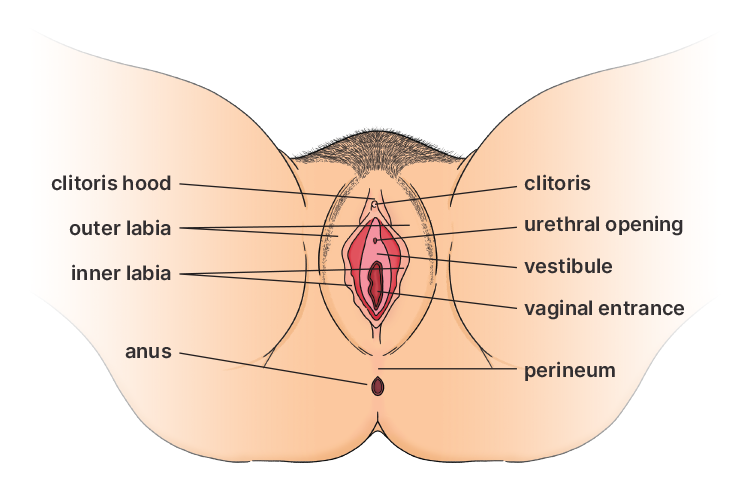It’s important to look after your vulva and vagina (female private parts). Many conditions that affect this area are common and easy to treat. But it’s important to talk to your doctor if you are worried.
What is the difference between your vulva and vagina?
Some people think the vulva and vagina are the same thing – but they are different. Your vulva is the external part of the female genitals that you can see. It includes:
- the area covered with pubic hair
- the outer lips, which are covered with pubic hair (labia majora)
- the inner lips, which are not covered with pubic hair (labia minora)
- the clitoris and its hood
- the urinary opening (where wee comes out)
- the vaginal opening.
Your vagina is inside your body. It extends from your vulva to the start of your uterus. Your vagina is where your period flows down from the uterus, where you can have penetration (e.g. sex) and where babies pass through during childbirth.
Diagram of the vulva and vagina

What can affect this area?
Irritation
The skin of your vulva is very delicate, so many things can cause irritation.
Vulval irritation can be uncomfortable. Symptoms can include:
- burning or itching
- the feeling of crawling under your skin
- redness or swelling
- skin cracking or splitting
- skin whitening
- painful sex.
Discharge
All women have vaginal discharge and fluids that keep the vulva and vagina moist and healthy. But sometimes discharge is caused by an infection.
Infection
There are different infections that can affect the vulva and vagina, for example, thrush. Thrush is a common infection, caused by candida, that affects around 75% of women at least once during their lifetime.
A vaginal infection can cause symptoms such as:
- burning or itching around the vulva
- vaginal discharge that is smelly or a different colour to normal
- a stinging feeling when weeing
- swelling or redness of the vulva and vagina
- splits in the skin of the vulva
- painful sex.
Allergies and skin conditions
Some products can cause an allergic reaction that might make the vulva itchy and red. For example, tampons, soaps, tight synthetic pants (Lycra) and chlorine (from swimming pools). There are other skin conditions that can affect the vulva.
Ageing
Around the time of menopause, your vulval and vaginal skin may get thinner, leading to dryness, irritation and pain during sex.
Vulval and vaginal pain
Vulval and vaginal pain can be caused by different things. For example, infections, skin conditions, pelvic floor muscle tightness, nerve damage and tissue damage from surgery or childbirth.
When to see your doctor
It’s important to see your doctor if you are worried about vulval irritation, discharge or pain.
Your doctor might do an examination, swab or other tests to find out what is causing the problem. Depending on the cause, they might give you ointments, creams or tablets. They may also give advice about how to look after this area. In some cases, they might refer you to a specialist.
Related resources
For more information, resources and references, visit the Jean Hailes vulva and vagina web page. You can also learn how to do a vulval self-check.
We also produce an Easy Read version of our vulval and vaginal health fact sheet.
© 2025 Jean Hailes Foundation. All rights reserved. This publication may not be reproduced in whole or in part by any means without written permission of the copyright owner. Contact: licensing@jeanhailes.org.au
